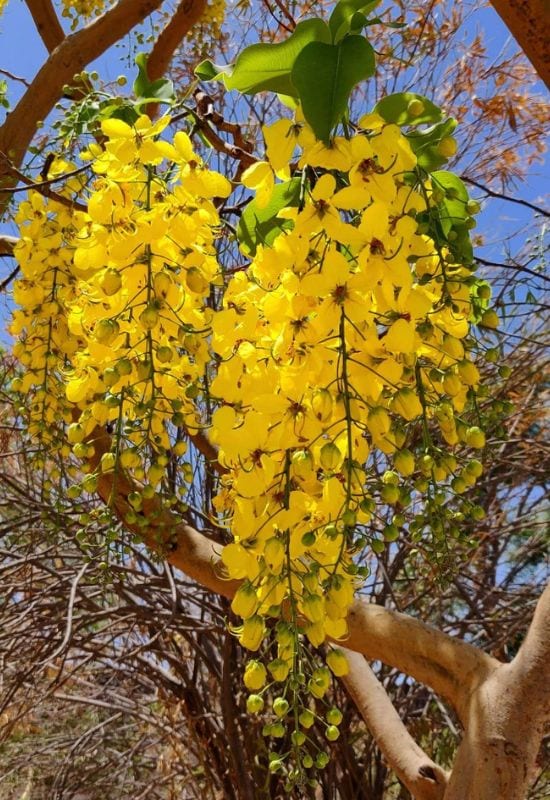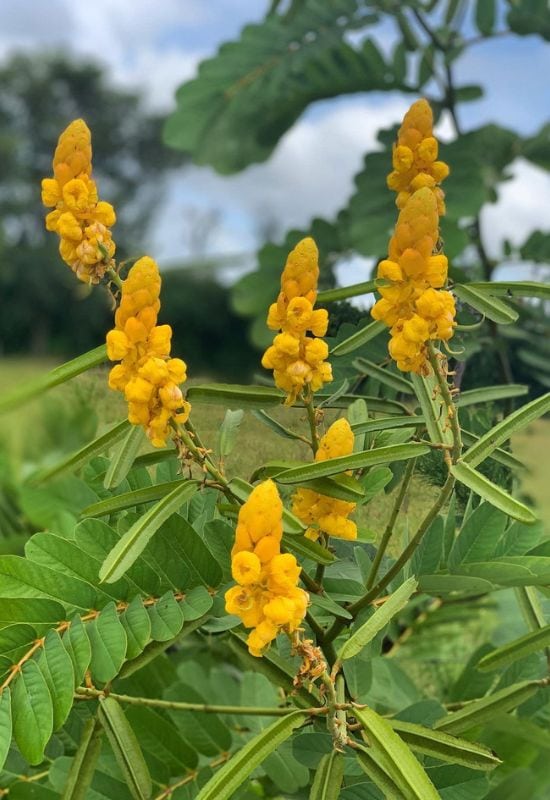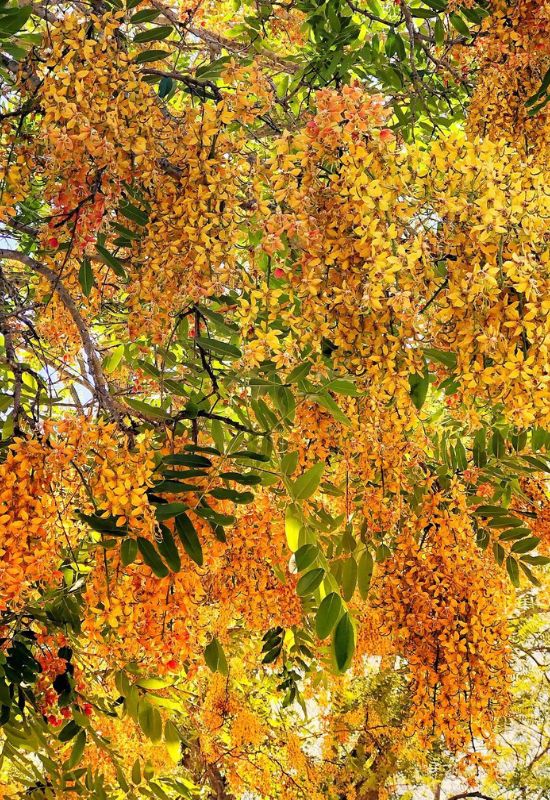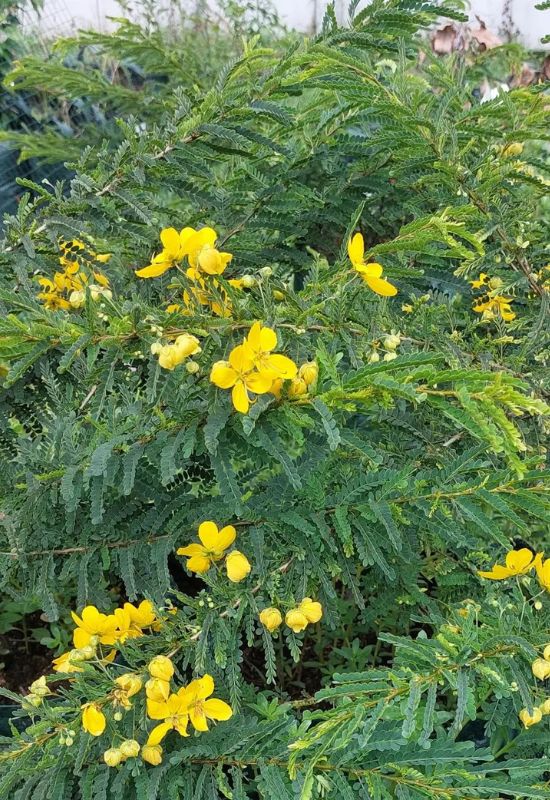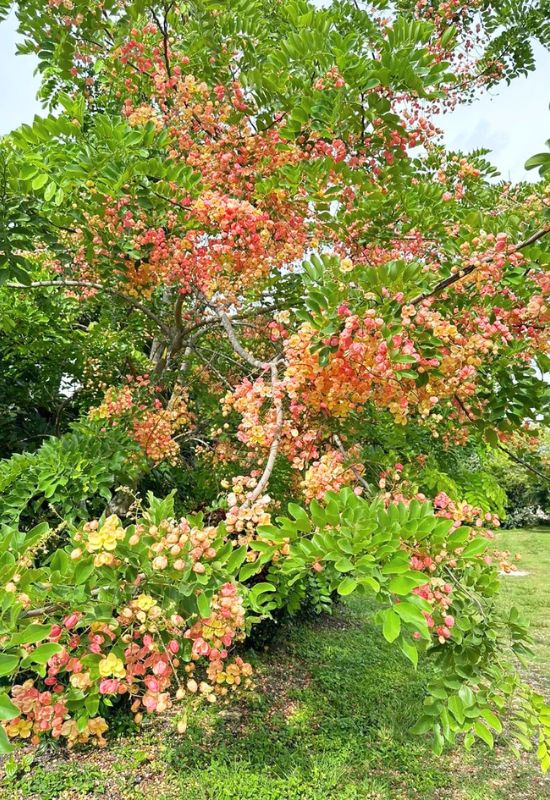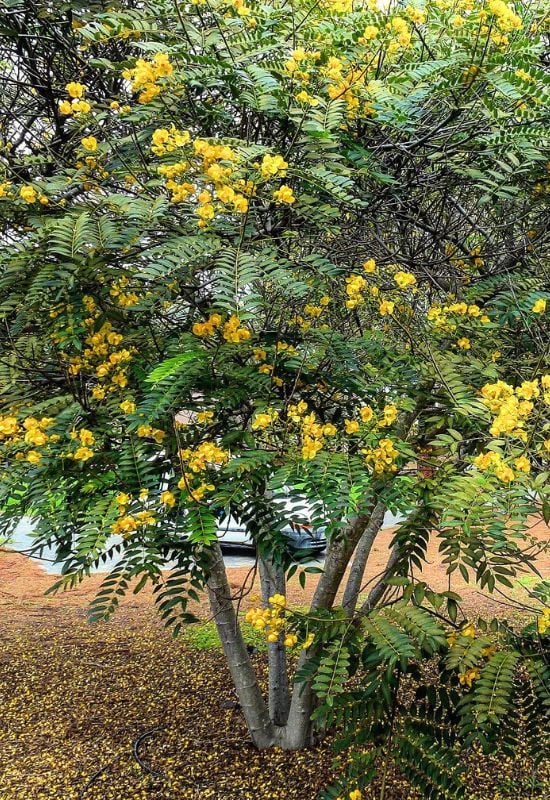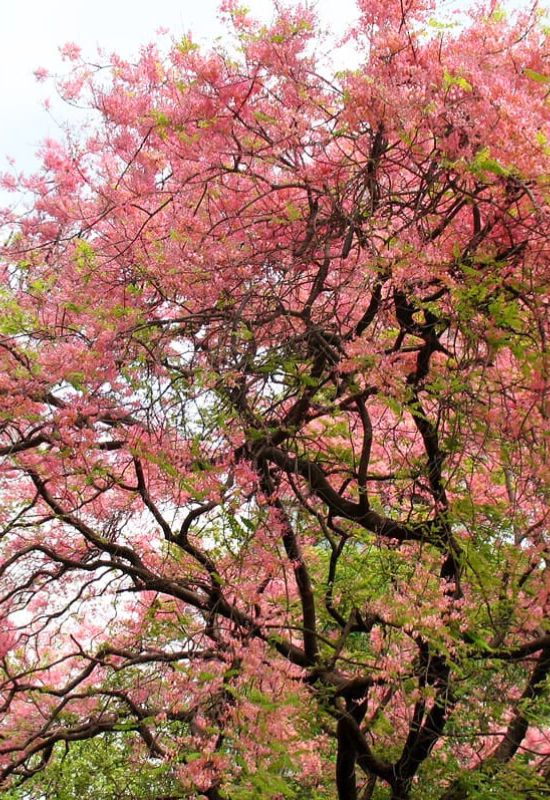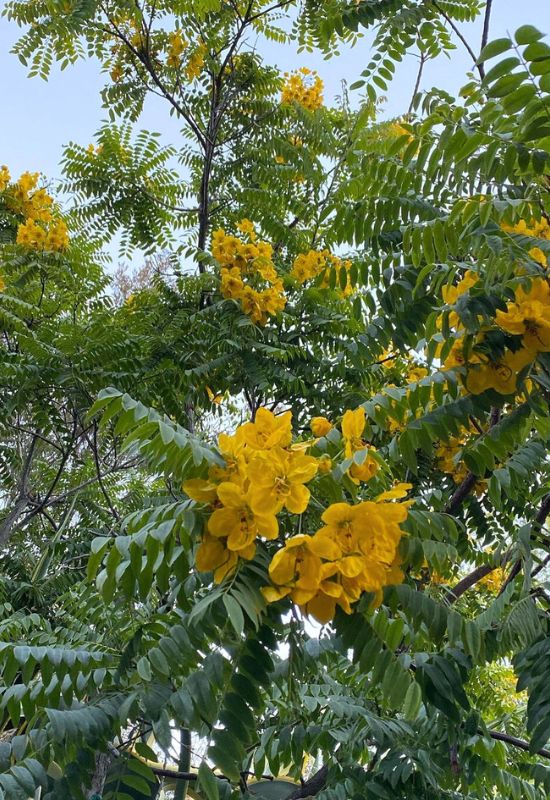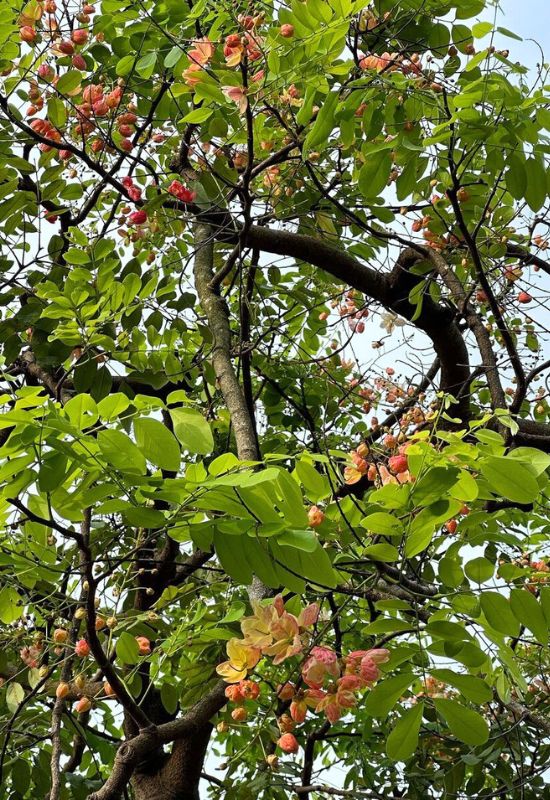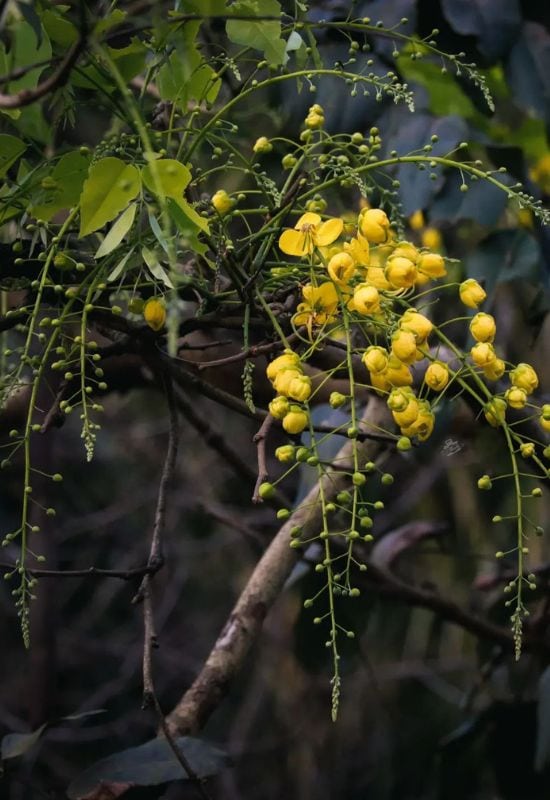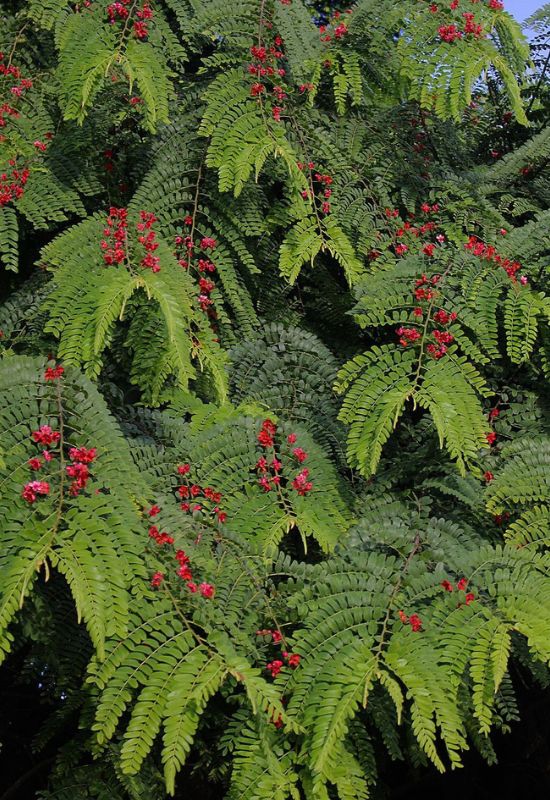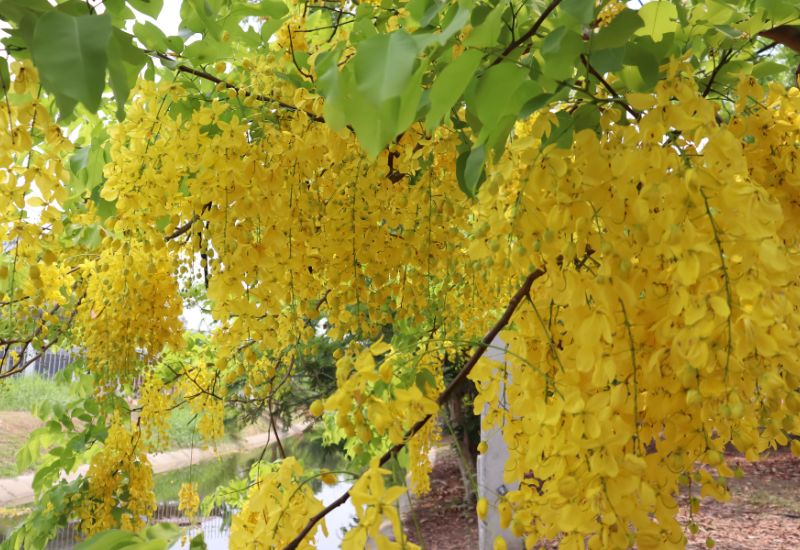
What a wonderful friend is a cassia tree to gardeners! Their massive blooms in so many colors, amazingly fine foliage, with the texture of filigree… and then the pods that hang from the branches and shake in the wind!
Grow one and your green haven will have a new queen, that brings the florid and exotic touch you need, but with an elegance that’s hard to match. For this, many varieties cassia trees are excellent for many landscaping styles, not just exotic, but traditional too, and they would feel at home even in a cottage garden…
Native to tropical and subtropical areas all over the world, including rainforests, these decorative trees, for gardeners, mean the members of two genera, Cassia and Senna, both of the Fabaceae family, the same as humble but beautifully flowering peas and beans!
And like them, they have great uses even beyond gardening; in fact, deforestation owes a lot to them! And they are also great nitrogen fixers, restoring impoverished soil!
So, you have many reasons to grow a type of cassia tree in your garden, but the question is: which is the best variety for you? Well, let’s try to find out together!
12 Colorful Cassia Tree Varieties to Add Splashes of Color to Your Garden
All these varieties of cassia trees will give you incredible blooms, and they come in many colors, not just yellow. But don’t forget their fine foliage and long pods…
And the cassia tree variety first on our list is a real classic…
1: Golden Shower Tree (Cassia fistula)
Of course, we want to meet one of the most popular species of Cassia in the world, known as golden shower tree! Native to India, Malaysia and Southeast Asia, it has become a favorite in gardens all over the world.
And of course, it has, its impressive and fragrantblossoms are impossible to resist… Or ignore, because this tree will light up with the very color of the Sun for two to three months in late spring and summer!
The hanging panicles contain so many flowers that they look like waterfalls of gold, as their yellow is so vibrant that you need sunglasses to look at them. Move close and you will see that each bloom is about 1.4 inches across (3.5 cm), with five oval petals that reflex as they mature.
But there are also very decorative arching stamens that drop the pollen on the back of the many pollinators that come to visit them. And the anthers can be yellowish to rusty orange in shade.
Followed by juicy pods that start off as green then reddish brown and ripen to almost black, they hang under a canopy of amazingly fine, pinnate leaves with a bright, fresh and energetic green color, up to 18 inches long (45 cm)!
Also grown for its edible flowers, leaves and pod pulp, golden shower tree is a wonderfully energetic variety of Cassia for any informal garden that needs an injection of light and energy, even an oriental style one.
2: Pink Shower Tree (Cassia bakeriana)
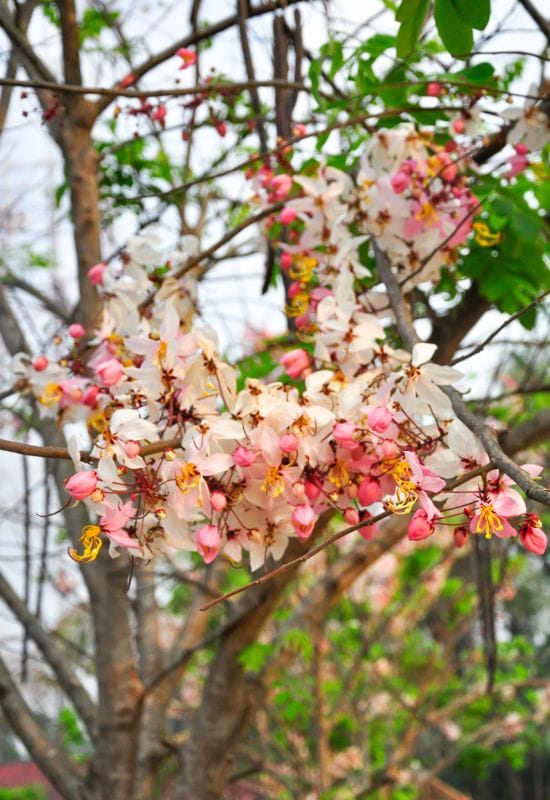
And we change color… Pink shower tree is the romantic sister of energetic Cassia fistula, and it comes to us from its native countries of Thailand and Myanmar… And what a spectacle it is!
Its fragrant flowers are so numerous and profuse that they literally fill all the spreading branches for about two months, announcing the good season with a bang! This spring bloomer, in fact, has drooping racemes with about 20 to 40 heads each, and about 4 to 10 inches long (10 to 25 cm); but you will get loads of them!
On close inspection, you will see that the blossoms have elongated petals, softly pointed that form stars, and they can display a range of hues, from super soft pink to rose, and sometimes even touching magenta notes.
On the other hand, the protruding reproductive organs are of a butter yellow tone, adding some contrast, and the anthers can be orangish. This effect is heightened by the fact that it happens when the leaves are still small, but they will grow!
And they will reach 16 inches (40 cm); they are bright green, pinnate and with oval leaflets. That’s the same as the pods’ length (they can actually reach 2 feet, or 60 cm)… And these ripen it a mellow brown tonality, a lovely contrast to the finely grooved gray bark.
For an early spectacle, like a cherry blossom but longer and with a more exotic feel, and then amazing pods and foliage, pink shower tree is a really superb choice, even for a medium sized garden, being a fairly small variety.
3: Candlestick Cassia (Senna alata)
Known by many names, including empress candle plant, candlestick cassia is actually a Senna species, native to tropical forests in Venezuela, Brazil and Columbia, and it is a shrub or small tree.
You may need to train it, picking one branch to turn into a trunk, but this little effort is really worthwhile… In fact, it is very decorative, to the point of being sculptural. And this is partly due to the spikes of super bright and rich, golden yellow flowers that it produces… As the name suggests, they grow upright and straight, like candles of light!
They are pea shaped and rounded, quite intriguing to look at, and they attract lots of pollinators. These will appear late in the season, in fall, when your garden most needs some extra sunny energy.
They also open from pinkish to orangish buds, giving you a twist at the tips! But there is yet another element that’s quite an asset! The evergreen pinnate leaves, about 24 inches long (60 cm), have a strong and stiff mid rib which keeps them straight, often pointing out, like hard fronds!
The leaflets are oblong and leathery, adding another exotic twist! The pods ripen to pale brown, and they are short, with visible bumps around the seeds; they are edible but in small quantities and used as a coffee substitute.
Small but very striking, candlestick cassia can be part of a border as a shrub, but it is also an ideal dwarf tree for a modest sized garden that needs a very sculptural exotic variety for great foliage all year round and golden flames late in the season. And it is an outstanding nitrogen fixer! It is also an important medicinal plant!
4: Brewster’s Cassia (Cassia brewsteri)
A variety from the Southern hemisphere, and exactly from Queensland, Australia, is Brewster’s cassia, and it has become popular in Los Angeles, also because it tolerates long periods of drought. It is also called bean tree, but it can turn into a shrub if you let it grow wild.
As a tree, it has variable size, from small to medium, but we want to talk about its blooms! They come in drooping racemes, and they are some of the most colorful of all these plants.
In fact, both the petals and the sepals are colored, and you can see reds (including strong scarlet), yellows, pinks or sometime lime, in many combinations between the two parts of the fragrant flowers.
When young, the blossoms keep their petals close together, forming a sphere (hence the pea reference) and the sepals form a plump star at the back. They open in late summer, and they are so profuse that the whole crown explodes with colors and pollinators.
The leaves are typically pinnate, with bright to mid green, glossy leaflets that reach about 2 inches long each (5.0 cm). The pods mature to a shiny dark brown, and they are clearly segmented, looking like big worms hanging from the branches…
If you like lots of colors, then Brewster’s cassia is the variety that you have been looking for. Growing it in your garden is like having a belated carnivalwith lots of confetti dropping from its branches. And if you live in a hot country, you will enjoy its foliage all year round as well (it is semi evergreen).
5: Desert Cassia (Senna polyphylla)
As the name suggests, desert cassia (Senna polyphylla) will withstand long periods of drought, but it does not hail from arid regions. On the contrary, this variety is native to the Caribbean Islands, and it is usually a small tree, often multi trunked, with excellent decorative value.
For a start, it has an impressive blooming season, from spring to fall! Next, the flowers are really prolific, coming on the branches in great numbers. At times, they literally cover all the elegantly arching branches with their luminous and energetic golden yellow color.
Each flower is about 1 inch across (2.5 cm) and it has five clearly divided petals that give you the impression of butterfly wings, in many ways. This is also because the center is very small, while a long and thin pistil extends forward like a proboscis…
What brings this floral display to the foreground is also the foliage itself, because the the pinnate evergreen leaves have 3 to 15 very small ovate leaflets, only 0.16 to 0.4 inches long (0.4 to 1.0 cm).
This gives you an exceptional texture, like fronds, but also very open bright green leafy crown. The pods are about 4 inches long (10 cm), and they ripen to a glossy dark brown with purple overtones.
Excellent as an accent tree even in a small garden, desert senna guarantees luminous blooms all through the season and immensely fine foliage all year round.
You could also have it as a yellow flowering shrub, but I think as a tree it is far more valuable. However, do not grow it over pipes or other underground structures, as it has an incredibly deep and strong taproot!
6: Apple Blossom Tree (Cassia javanica)
Apple blossom is a large tree, also called Java cassia, native of Southeast Asia. It has a very decorative spreading crown, often in the shape of a broad umbrella, where its generous clusters of flowers hang during spring.
And here is where it comes one of its names, because they have a very strong apple fragrance!
What is more, they are really enchanting with their range of pink shades, including rose (in the bids and open blossoms), and soft, shell, and, as they mature, they pale slowly to whitish tones.
The overall effect is luminous, suave and energetic at the same time – and jaw dropping indeed! And its blossoms can be quite showy individually as well, ranging between 1.2 and 2.8 inches in diameter (3.0 to 7.0 cm)!
They have five board, delicate looking petals and in the center, five diamond shaped dark purple patches and a long, hooked green pistil which turn bright yellow when fertilized!
These are followed by cylindrical pods that ripen to dark brown, while the evergreen foliage is feather like, compound (pinnate), bright green and up to 12 inches long (30 cm).
Fast growing and strong, apple blossom tree will be a protagonist in any spring garden, where it is best to grow it as a specimen and accent plant, and then, for the rest of the year, it will still gives you lots of super fine texture and the decorative pods.
7: American Cassia (Senna spectabilis)
American cassia, a.k.a. popcorn tree, is a Senna variety from the New World, which owes its fortune with Humankind thanks to its great medicinal properties, but also for its decorative value. Growing into a small or medium sized tree with a broad and spreading crown, it is also used against deforestation, but it can also become invasive.
But you won’t regret having it in your garden, especially in summer, when many drooping clusters of about 15 to 20 fragrant flowers will descend from its branches above your head.
Each bloom is about 1.4 inches across and showy, with three broad and round petals at the top and two oval and smaller ones at the bottom, for a perfect butterfly impression.
These blossoms are usually golden yellow, however, sometimes they have some white, and at times they also darken in shade. Two long arching stamens like elephant tusks protrude forward and upward, ending in long dark rust red anthers, while the hooked pistil is green.
Followed by long pods (12 inches,or 30 cm), they mix with the lush evergreen foliage, with the typical pinnate shape and feathery texture,and a bright green color.
Fast growing but with moderate drought tolerance, American cassia is cold hardy compared with other varieties, and this makes it ideal for gardens in temperate regions. Choose it as a specimen or accent tree, and it is also popular in public parks and on sidewalks.
8: Carao (Cassia grandis)
Also called pink shower tree (as well!) or coral shower tree, Carao is the common Spanish name of a giant of the genus from southern Mexico, Venezuela and Ecuador, as it reaches 98 feet in height (30 meters).
Grown for the syrup you can obtain from its ripearomatic pods, called carobs, which are about 20 inches long (50 cm), it will literally blow your mind when winter comes to a close… Yes, because this early bloomer will start in February, and it will turn into a floral spectacle like few you have ever seen!
The clusters of blossoms are extremely dense, and this plant will produce huge numbers. Each flower has five oval elongated petals, with dark diamond shaped dots at the center and hooked pistils (green) and stamens (yellow).
The color? We could say pink, but you can actually see lots of shades, even in the same raceme or blossom from soft to rose, and hints of white as well! There are also varieties that have yellow and, of course, salmon and coral in their palette!
This show will last till mid spring, and in some cases, it will happen when the branches are still naked, turning the whole crown into a rosy display!
In fact, the foliage is semi evergreen and it will fall in colder countries, and it has the pinnate and finely textured leaves we expect from cassias, bright green in color. If it gets dry, it will also shed its lush leafy coat in summer, but don’t worry, it will grow back.
An ideal choice for a large garden, carao has a floral display that is impossible to resist! It’s like a massive cherry blossom, but available in many shades, that lasts for months, and it will certainly need a prominent place, center stage in your green haven.
9: Gold Medallion Tree (Cassia leptophylla)
Native to Brazil, gold medallion tree is a really stunning variety of cassia! To start with, it will blossom intermittently throughout the whole year! And will do this with big and showy flowers, up to 3 inches across (7.5 cm), and lots of them.
Unlike in other species, the blooms are grouped in dense round terminal clusters, that give you large, energetic globes at the tips of branches! They have five broad petals, decidedly bright yellow and very fragrant, on the golden range but very deep, and saturated indeed!
A long and narrow pistil extends outward as do arched stamens, and all the reproductive organs end in reddish, at the stigma and on the anthers. The pods are extremely long, up to 2 feet (60 cm), their cross section is triangular and they rattle beautifully in the wind!
The pinnate leaves too are on a large scale and drooping, up to 18 inches (45 cm) and bright to dark green, semi glossy in color. It is semi evergreen as well, so you may well enjoy its foliage in winter as well.
With a large and spreading crown, gold medallion tree may be the most rewarding cassia variety for the length, size and shape of its blooms, and an excellent choice if you want to enjoy them in the shade of its decorative foliage.
10: Rainbow Shower Tree (Cassia x nealiae)
If you love colors, you won’t resist rainbow shower tree! This is a natural hybrid of cassia, and it looks like Mother Nature has a flair for Impressionist painting… As the name suggests, the flowers have, indeed an impressive palettes.
Coming in long, hanging and dense racemes all the way from mid spring to early fall (!!!), the blooms can display any shade of white, yellow, pink and even orange!
This will happen within the clusters, each about 1 foot long (30 cm), and you will see even delicate tonalities like coral, peach, salmon, sand, honey, apricot or shell on the blossoms.
Each head is about 1 inch across (2.5 cm) and they have arching, hooked reproductive organs in the middle. This fragrant floral display will give way to long pods that ripen to a very sumptuous dark brown.
The long semi evergreen leaves reach 16 inches (45 cm), and they have a glossy surface on the many ovate leaflets, on a scale of emerald from pale to deep.
For a long and colorful, jaw dropping floral display in your garden, rainbow shower tree is just a magnificent choice. Of course, it heeds a prominent position, as ut will steal the show anyway…
11: Long Pod Cassia (Cassia abbreviata)
Native to Africa, long pod cassia has something very special about it… And it is not just its long lasting blossoms, which start in August and continue till late in the season, stopping only in October.
Its panicles can reach 1 foot in length (30 cm), and they hang beautifully on the branches, often with an open and wild look.They are attractive to butterflies and many other pollinators, which are attracted by the scent and the bright golden yellow color of this floral display.
The blooms are different from other varieties, more star shaped, with elliptical petals, which keep together in a lantern shape for days before opening wide to form a star… Typically, they have long and curving reproductive organs, greenish and cream in color, and each blossom can be 1.8 inches across (4.5 cm).
As its name gives away, these are followed by very, very long pods, up to 3 feet (90 cm)! They will maintain a pinkish coloring for a long time, before ripening to dark brown.
The semi deciduous foliage has the classic pinnate shaped leaves, on the glaucous side and bright to mid green.
Long pod cassia may not be as popular as other varieties in gardens, but its extended bloom time and magnificent pods can have great decorative value, especially in a natural looking garden, and it is especially suitable for dry regions.
12: Red Cassia (Cassia roxburghii)
And we close with a variety that few people know… Native to India, red cassia is quite an original species… I also think it is one of the most elegant of these trees, and this is thanks to its arching and descending branches, which, together with the long and drooping evergreen foliage gives it an almost weeping habit.
On this lush and leafy spreading crown, you will also, of course, see its beautiful flowers. But they are not exactly red… In fact, they can be pink, orange or rose, often with coral tonalities.
Anyway, it makes for an impressive display, which lasts all the way from late spring to mid summer. The panicles will hang from the tips with large and fragrant blossoms.
In fact, each head can reach 2.8 inches across (7.0 cm), and the petals are quite fleshy, oval and elongated, and really attractive even when they form globes of bright color before opening wide.
When they do, they reveal tusk like stamens that end in very dark red anthers, as are the stigmas. The pods ripen to a glossy dark brown, while the leaves have the best feathery texture you can expect from these trees. Bright to mid green, they spread like fronds to the sides of central stems, waving in then wind.
If you want elegance and a warm, but also sophisticated bloom color, red cassia can be a flowering queen in your garden like few other trees can ever be.
Amazing Cassia Trees in Many Colors
For sure, cassia trees are really great friends to us Humans, they give us medicine, food, they fix nitrogen, fight against deforestation…
But we also love them for their decorative pods, finely textured foliage and, above all, their fragrant and colorful, massive blooms in yellow, but also white, pink, red…

Written By
Andrew Zubek
From Northern Ohio, he received a Bachelor’s degree in Botany and Marketing from Miami University of Ohio. Whether it is in the midwest, along the west coast, in the valleys, in the desert, or in the city, he has unique experience growing in many different microclimates having lived in multiple different climate zones. Helping to establish a landscape company focused on edible landscapes, he leads their nursery cultivating over 100 edible varieties of plants. Receiving his Certified Arborist certificate from the International Society of Arboriculture in 2019, he has spent the past few years focused on trees, especially food producing varieties. He hopes to open the world’s eyes to the importance of respecting our environment and giving back as much as it has given to us.

